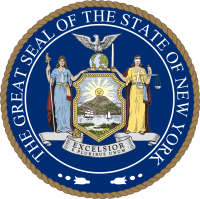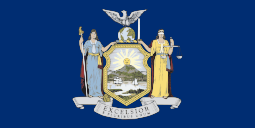Qualified New York political parties
In New York State, to qualify for automatic ballot access, a party must have received at least 50,000 votes in the previous gubernatorial election. A party must run a gubernatorial candidate (as well as a lieutenant governor candidate, although the state will accept petitions without a lieutenant governor candidate if no other candidate challenges them) to be eligible for automatic ballot access; if 50,000 voters vote for that candidate on their party line, they have qualified the party for the next four general elections. A party that is not qualified may run candidates by completing a petition process. Parties are also allowed to cross-endorse candidates, whose votes are accumulated under electoral fusion, but any parties must cross-endorse both the governor and lieutenant governor candidates for fusion to apply. Parties that are already qualified must issue a Wilson Pakula authorization if they cross-endorse someone not enrolled in that party; there are no restrictions (other than that the candidate must be eligible for office) on who can be nominated on a non-qualified ballot line, as these lines are determined by filing petitions.
| Elections in New York State | ||||||||||||
|---|---|---|---|---|---|---|---|---|---|---|---|---|
 | ||||||||||||
|
||||||||||||
|
|
||||||||||||
|
||||||||||||
For statewide and special elections, automatic ballot access means that no petitions have to be filed to gain access to a ballot line, and party organizations can endorse candidates through their own conventions (this does not apply to legislative candidates, who still must petition onto the ballot regardless of party endorsement, but are only required to collect a third of the signatures required of non-qualified parties). Qualified parties also are the only parties eligible to hold primary elections in the state-run primary elections. In addition to determining whether they automatically qualify for the next four years, this also determines the order on the ballot; qualified parties are ranked in order of gubernatorial votes, with the party having the most votes atop the ballot.
In the 1994 election, the Democratic Party received the most votes, and so qualified to be first on the ballot for the next four years, even though their candidate, incumbent Governor Mario Cuomo, lost. George Pataki beat him because he received more votes combined over all of his party lines.
In the 2002 election, three qualified parties failed to re-qualify: the Liberal Party, Right to Life Party, and the Green Party. The Liberals became dormant, the Right to Life dramatically scaled back its operations, while the Greens continued mostly unaffected before re-qualifying in 2010. The same five parties who qualified in 2002 re-qualified in the 2006 election. After the 2010 elections, these parties with ballot access were joined by a sixth party, the Green Party.
Two additional parties qualified in the 2014 elections: the Women's Equality Party (a front for incumbent Governor Andrew Cuomo) and the Stop Common Core Party (a line created by Republican candidate Rob Astorino), later renamed the Reform Party. Both parties failed to re-qualify in the 2018 elections and were replaced with the Libertarian Party and Serve America Movement party who qualified.
Parties that do not qualify automatically can petition their way onto the ballot. For statewide candidates, this requires 15,000 signatures, and requires 100 signatures in at least half of the congressional districts in the state.[1] The Socialist Workers Party regularly used this approach to appear on the ballot before abandoning its ballot-access efforts in 2010, then stopped running statewide candidates entirely in 2018. These parties also are not eligible to run primaries, and the first person to submit 15,000 signatures automatically gets the party line. (Sam Sloan attempted to use this tactic to take the 2010 and 2014 Libertarian gubernatorial nominations from that party's nominee, this before the Libertarians gained ballot access in 2018, but failed for lack of signatures.)
1994
| Party | Candidate | Votes | % | ± | |
|---|---|---|---|---|---|
| Democratic | Mario Cuomo | 2,272,903 | 43.80 | -7.62 | |
| Republican | George Pataki | 2,156,057 | 41.55 | +20.20 | |
| Conservative | George Pataki | 328,605 | 6.33 | -14.07 | |
| Independence | B. Thomas Golisano | 217,490 | 4.19 | N/A | |
| Liberal | Mario Cuomo | 92,001 | 1.77 | +0.02 | |
| Right to Life | Robert T. Walsh | 67,750 | 1.33 | -2.07 | |
| Tax Cut Now | George Pataki | 54,040 | 1.04 | N/A | |
1998
| Party | Candidate | Votes | % | ± | |
|---|---|---|---|---|---|
| Republican | George Pataki | 2,223,264 | 47.37 | +5.82 | |
| Democratic | Peter Vallone | 1,518,992 | 32.36 | −11.44 | |
| Independence | B. Thomas Golisano | 364,056 | 7.76 | +3.57 | |
| Conservative | George Pataki | 348,727 | 7.43 | +1.10 | |
| Liberal | Betsy McCaughey Ross | 77,915 | 1.66 | −0.11 | |
| Right to Life | Michael Reynolds | 56,683 | 1.21 | −0.10 | |
| Green | Al Lewis | 52,533 | 1.12 | +1.12 | |
| Working Families | Peter Vallone | 51,325 | 1.09 | +1.09 | |
2002
| Party | Candidate | Votes | % | ± | |
|---|---|---|---|---|---|
| Republican | George Pataki | 2,085,407 | 46.86 | −0.51 | |
| Democratic | Carl McCall | 1,443,531 | 32.44 | +0.07 | |
| Independence | B. Thomas Golisano | 654,016 | 14.70 | +6.94 | |
| Conservative | George Pataki | 176,848 | 3.97 | −3.46 | |
| Working Families | Carl McCall | 90,533 | 2.03 | +0.94 | |
2006
| Party | Candidate | Votes | % | ± | |
|---|---|---|---|---|---|
| Democratic | Eliot Spitzer | 2,740,864 | 62.85 | +30.41 | |
| Republican | John Faso | 1,105,681 | 25.35 | −21.51 | |
| Independence | Eliot Spitzer | 190,661 | 4.37 | −10.32 | |
| Conservative | John Faso | 168,654 | 3.87 | −0.11 | |
| Working Families | Eliot Spitzer | 155,184 | 3.56 | +1.52 | |
2010
| Party | Candidate | Votes | % | ± | |
|---|---|---|---|---|---|
| Democratic | Andrew Cuomo | 2,610,123 | 56.08 | -6.77 | |
| Republican | Carl Paladino | 1,290,017 | 27.72 | +2.37 | |
| Conservative | Carl Paladino | 232,264 | 4.99 | +1.12 | |
| Working Families | Andrew Cuomo | 154,487 | 3.32 | -0.24 | |
| Independence | Andrew Cuomo | 146,646 | 3.15 | -1.22 | |
| Green | Howie Hawkins | 59,928 | 1.29 | +0.40 | |
2014
| Party | Candidate | Votes | % | ± | |
|---|---|---|---|---|---|
| Democratic | Andrew Cuomo | 1,811,672[2] | 47.08 | -9.00 | |
| Republican | Rob Astorino | 1,234,951[2] | 32.59 | +4.87 | |
| Conservative | Rob Astorino | 250,634[2] | 6.6 | 1.75 | |
| Green | Howie Hawkins | 184,419[2] | 4.86 | +3.57 | |
| Working Families | Andrew Cuomo | 126,244[2] | 3.22 | -0.10 | |
| Independence | Andrew Cuomo | 77,762[2] | 2.02 | -1.13 | |
| Women's Equality | Andrew Cuomo | 53,802[3] | 1.41 | N/A | |
| Stop Common Core | Rob Astorino | 51,294[3] | 1.39 | N/A | |
The Stop Common Core Party rechristened itself the Reform Party, initially unrelated to the national Reform Party, on February 17, 2015. In an effort to quash a trademark infringement dispute from the national Reform Party, the state party allowed national Reform Party officers, including chairman Bill Merrill, to take over the party. In September 2016, Curtis Sliwa orchestrated a hostile takeover of the Reform Party, and it is no longer related to the national party.
2018
| Party | Candidate | Votes | % | |
|---|---|---|---|---|
| Democratic | Andrew Cuomo | 3,158,459 | 54.53 | |
| Republican | Marcus Molinaro | 1,824,581 | 31.50 | |
| Conservative | Marcus Molinaro | 238,578 | 4.12 | |
| Working Families | Andrew Cuomo | 106,008 | 1.83 | |
| Green | Howie Hawkins | 95,716 | 1.65 | |
| Libertarian | Larry Sharpe | 90,816 | 1.57 | |
| Independence | Andrew Cuomo | 63,518 | 1.10 | |
| SAM | Stephanie Miner | 51,367 | .89 | |
For the first time in the 48-year history of the Libertarian Party of New York, the party qualified for automatic ballot access with Larry Sharpe's 90,816 votes. In addition, Stephanie Miner achieved automatic ballot access for the newly created Serve America Movement line. The Women's Equality Party and the Reform Party failed to re-qualify.
References
- "Running for Office". New York State Board of Elections. Retrieved July 17, 2015. (official site)
- http://nyenr.elections.state.ny.us/home.aspx
- Waldman, Scott (November 5, 2014). Women's Equality Party secures ballot line. Capital New York. Retrieved November 5, 2014.
